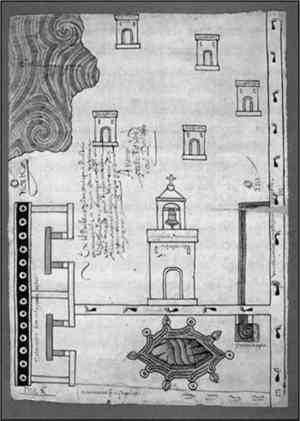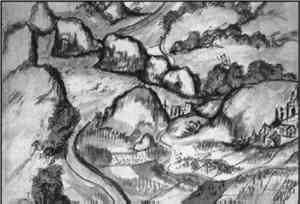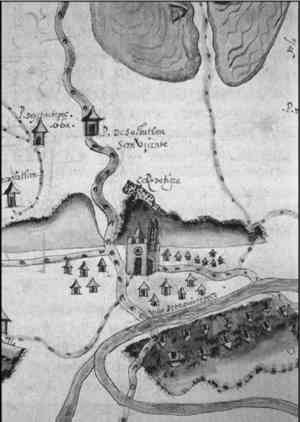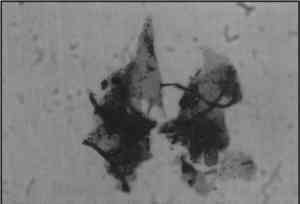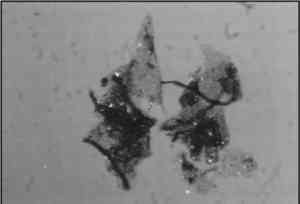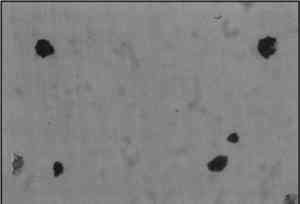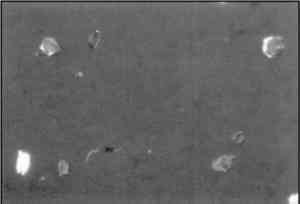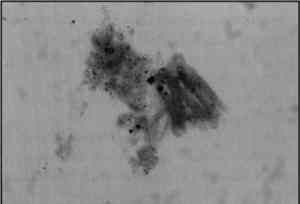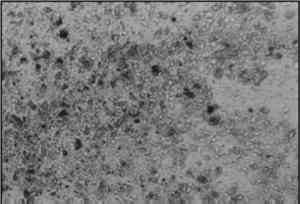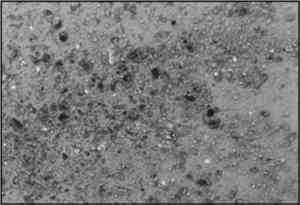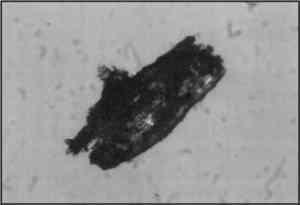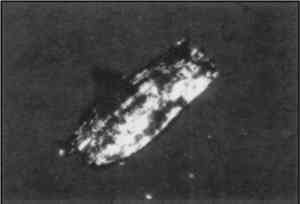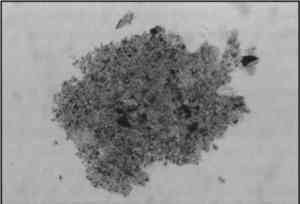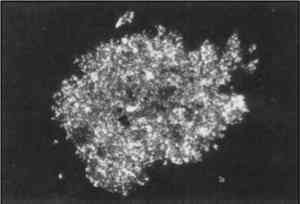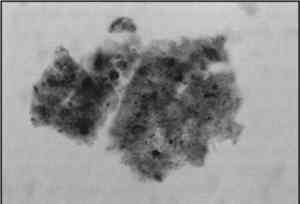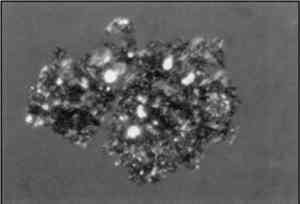IDENTIFICATION OF COLORANTS ON MAPS FROM THE EARLY COLONIAL PERIOD OF NEW SPAIN (MEXICO)MARY ELIZABETH HAUDE
ABSTRACT—Six hand-drawn maps from the Benson Latin American Collection at the University of Texas at Austin underwent treatment at the university's Preservation and Conservation Studies laboratories in the spring of 1996. These objects, from a group of maps and manuscripts known as the Relaciones Geogr�ficas, were created for Philip II of Spain between 1578 and 1585 as part of a survey of New Spain (Mexico), Central America, South America, and the Spanish West Indies. The Relaciones Geogr�ficas were produced in the early colonial period of New Spain (ca. 1521–1600). Manuscripts from this transitional period often combine Native (i.e., Mixtec, Aztec, Zapotec) and European pictorial and design elements. The author initially assumed that the colorants on these six maps, like the pictorial elements, would combine Native and European technologies. Twenty-two colorants were sampled and analyzed by transmitted polarized light microscopy. This article will identify several of the samples and compare them to documented colorants from the early colonial period of New Spain. An inventory of known colorants from this period and region is provided. TITRE—Identification des colorants sur des cartes datant des d�buts de la p�riode coloniale en Nouvelle-Espagne (Mexique). R�SUM�—Au printemps 1996, six cartes dessin�es � la main, provenant de la collection latino-am�ricaine Benson � l'universit� du Texas � Austin, ont fait l'objet de traitements au laboratoire d'�tudes en pr�servation et restauration (Preservation and Conservation Studies laboratories) de l'universit�. Ces documents font partie d'un ensemble de cartes et de manuscrits, connu sous le nom de “Relaciones Geogr�ficas”. Ils furent cr��s entre 1578 et 1585 pour Philippe II d'Espagne lors d'un relev� des terres de Nouvelle-Espagne (Mexique), d'Am�rique latine, d'Am�rique du Sud et des Antilles espagnoles. Les “Relaciones Geogr�ficas” datent donc des d�buts de la p�riode coloniale de la Nouvelle-Espagne (environ 1521–1600). Les manuscrits de cette p�riode de transition contiennent souvent des �l�ments picturaux et conceptuels � la fois autochtones (mixt�ques, azt�ques, zapot�ques) et europ�ens. Pour cette raison, l'auteur croyait au d�part que les colorants utilis�s sur ces cartes, tout comme les �l�ments graphiques, corresponderaient � un mariage des technologies de sources autochtone et europ�enne. Des �chantillons de vingt-deux colorants furent analys�s par microscopie sous lumi�re polaris�e transmise. Dans cet article, plusieurs des �chantillons sont identifi�s et compar�s aux colorants d�j� document�s des d�buts de l'�poque coloniale de la Nouvelle-Espagne. Un inventaire est inclus des colorants document�s de cette r�gion, de l'�poque. TITULO—Identificati�n de colorantes en mapas del per�odo colonial temprano en Nueva Espa�a (M�jico). RESUMEN—Seis mapas dibujados a mano pertenecientes a la Colecci�n Latinoamericana Benson de la Universidad de Texas en Austin fueron sometidos a tratamiento en los laboratorios para Estudios de Preservaci�n y Conservaci�n de la Universidad, durante la primavera de 1996. Estos objetos, pertenecientes a un grupo de mapas y manuscritos conocidos como las Relaciones Geogr�ficas, fueron creados para Felipe II de Espa�a entre 1578 y 1585, como 1 INTRODUCTIONIn the spring of 1996, six hand-drawn, 16th-century maps from colonial New Spain were treated in the Preservation and Conservation Studies (PCS) laboratories at the University of Texas at Austin (UT-Austin). These maps are part of the Relaciones Geogr�ficas Collection, which belongs to UT-Austin's Benson Latin American Collection. The treatment of the maps led to a prefatory study of their history and manufacture. A unique feature of all six maps is their colorful and slightly unusual paint. Fascinated by this, I decided to begin the study by researching colorants (pigments and dyes) common in 16th-century New Spain (Mexico). My research followed two courses: a literature survey of documented pre-Columbian and New Spanish colorants and a preliminary microscopic examination of specific colorants sampled from the six maps. The results of the literature survey and the pigment analysis are included in this paper. The artistic style of the Relaciones Geogr�ficas (RG) reflects a blending of indigenous and European design. The supports of the RG maps are predominantly European rag paper, although there are maps on animal hides and indigenous amatl paper. Given the blend of artistic elements and the range of drawing supports, I presumed the paints and inks on the six maps would also be composed of Native and European pigments. I was given permission to remove pigment samples from the six RG maps for analysis. Because of the limited budget and limited access to analytical equipment, the examination of the samples was primarily restricted to optical microscopic analysis. Prior to and during the pigment analysis, I conducted an exhaustive yet incomplete literature survey to provide background information on pre-Columbian and Spanish Colonial pigments and to guide the identification process. The review of the literature spanned many disciplines, including botanical, historical, and conservation sources on pigments and dyestuffs used for a variety of objects such as murals, textiles, and manuscripts. The purpose of this article is to identify several of the colorants sampled from the six maps and to provide an overview of colorants used in 16th-century New Spain. I acknowledge the limitations of basing the identification of colorants on optical microscopic analysis; other analytical methods would provide more definitive results. In addition, I recognize that paint has other components, such as binders and grounds, and a thorough study would include these components. Therefore, this article is intended as a preliminary investigation of colorants in use during the early colonial period of New Spain and is by no means definitive. This article attempts to begin to understand the manufacture of early Spanish Colonial manuscripts and to contribute to the body of knowledge in the area of 16th-century New Spanish colorants. The primary focus of this article is historical; 2 BRIEF HISTORY OF NEW SPAINFor thousands of years, sophisticated civilizations prospered in what is now present-day Mexico and Central America. Large cities and ceremonial centers were built by various civilizations, notably by the Olmecs (1500–900 B.C.) along the Gulf Coast region of Mexico; the Maya (300 B.C.–A.D. 900) in Yucat�n; and the Toltecs (A.D. ca. 1000–1150) and later the Mexica, or Aztecs (A.D. 1325–1521), in the Valley of Mexico (Schele and Freidel 1990; Gruzinski 1992). With the rise of various civilizations came the establishment of complex political systems, religions, and social hierarchies. Prior to the arrival of the Spanish, indigenous Mexican cultures enjoyed a rich technological history. Among other achievements, these various cultures made paper, books, and pigments; painted murals, ceramics, and manuscripts; erected elaborate sculpture and architecture; cultivated crops and botanical gardens; and engaged in medical practice. In addition, written languages culminated in a strong tradition of written and pictorial texts, or codices. Particularly adept at creating pictorial manuscripts were the Mixtecs of southern Mexico, the Aztecs of central Mexico, and the Maya of the Yucat�n peninsula. Under the auspices of the priesthood, preconquest manuscripts and codices were produced by professional scribes from the Native elite (Peterson 1959; Robertson 1994). In 1519, Hern�n Cort�s landed in the Gulf of Mexico near the present-day port of Veracruz. While traveling along the Gulf Coast, Cort�s learned from various coastal peoples that much of the territory was dominated by an immense empire of the Aztecs. Upon arrival on the Gulf shores, representatives of this empire who were bearing food and precious gifts of gold, jewelry, fine cloths, and other luxuries, greeted Cort�s and his men. Cort�s, impressed by the wealth of these gifts, became eager to obtain riches in the New World. The Spaniards continued on to the Aztec capital Tenochtitl�n, present-day Mexico City. A war ensued between the Aztecs, led by Moctezuma, and Cort�s's Spaniards. Tenochtitl�n fell to the Spaniards in 1521, and with it the rest of the territory that became known as New Spain (Mexico) (Gruzinski 1992; Boone 1994). Native architecture and artifacts (sculpture, pottery, and murals) were rapidly and systematically destroyed by the Spanish in an attempt to eliminate any connection with Mexico's “pagan past” (Robertson 1994, 1). Pre-Columbian codices and manuscripts also perished in the hands of the Spanish. Many books burned inside their libraries when the conquering Spanish set entire towns aflame. Most, however, were destroyed by members of the Catholic Church, “particularly officers of the Inquisition, who saw in the books a challenge to the establishment of Christianity” (Peterson 1959, 240). Only a few pre-Columbian codices and manuscripts have survived and are scattered worldwide. The early colonial period of New Spain (ca. 3 RELACIONES GEOGR�FICAS3.1 HISTORYThe RG are a group of maps and manuscripts created during the early colonial period in response to a questionnaire developed for Philip II of Spain to survey the diverse regions of New Spain (Mexico), Central America, South America, and the Spanish West Indies during the years 1578–85. To date, Barbara Mundy's The Mapping of New Spain: Indigenous Cartography and the Maps of the Relaciones Geogr�ficas (1996) is the most definitive source on these particular New Spanish maps. Mundy thoroughly discusses the history of these maps and their manufacture through a joint effort of Spanish colonists and indigenous Mexicans. Juan L�pez de Velasco, Spain's cosmographer-chronicler of the New World colonies, devised the 50-item RG questionnaire and sent it to New Spain in 1578 (Mundy 1996). The questionnaire was widely distributed to Spanish officials in various regions of the newly founded Spanish colonies. The questions sought information on political jurisdiction, terrain, language affiliation, Native traditions, plant names, and mineral sources. In addition to the survey questions, a map of each region, called a pintura (painting, picture), was required (Cline 1972). Mundy (1996) indicates that answers to the questions were almost always supplied by Spanish administrators, but the majority of the maps were made by indigenous painters. She further emphasizes that these painters were likely of the Native nobility because painting was considered an elite vocation by pre-Columbian Mexicans. Catholic priests in New Spain continued training the indigenous elites to write and paint in the postconquest period. While the texts of the RG questionnaire were often signed by the respondents, only three maps were signed by the artists. In some instances, the respondents of the texts identify the artists of the corresponding maps. The author of the Relacion Geogr�fica of Ixtapalapa identifies the painter Mart�n Cano as an indigenous resident of Ixtapalapa (Mundy 1996); the Ixtapalapa map is discussed in this article. Mundy has identified other mapmakers by careful study of “individual drawing styles in order to correlate the author of the map to a particular scribe or signatory of the text” (31). Again, she believes that most of the maps were drawn by indigenous artists. The RG maps vary in artistic style from Native to European Renaissance. Many of the maps show neither predominately indigenous nor European conventions, but rather a blending of both artistic styles. Many of the indigenous artists responsible for creating the maps were trained in the art of writing and painting at monastic schools in New Spain. Native artists were taught European artistic conventions by copying graphic images from European prints available at the monasteries. Mundy emphasizes that prints also introduced these artists to illusionism where “painting should mimic visual experience” (Mundy 1996, 77). The inclusion of Native elements in the maps partly resulted from the rich pre-Columbian tradition of painting and writing. 3.2 PROVENANCECline (1972) estimates that of the 283 RG items recorded for New Spain, including texts and maps, 243 are extant. RG collections currently exist in three institutions, including the Benson Latin American Collection of UT-Austin, the Real Academia de la Historia in Madrid, and the Archivo General de Indias in Seville. The RGs began arriving in Spain in 1583 and, once there, were relocated several times. In 1787, the Archivo General de Indias in Seville obtained 80 texts and 22 maps (Cline 1972, 197). Cline indicates that nearly half of the RGs were lost between 1783 and 1853. In 1853, a portion of the lost manuscripts were purchased by Juaqu�n Garc�a Icazbalceta and moved from Spain to Mexico. Luis Garc�a Pimentel inherited the book and manuscript collection of Icazbalceta, his father, in 1894. In 1937 the family sold the collection, including the RGs, to UT-Austin (Cline 1972, 199–200). Currently, the Benson Latin American Collection houses 43 manuscripts and 37 RG maps. The Real Academia de la Historia in Madrid acquired approximately 46 of the aforementioned lost manuscripts in 1863 (Cline 1972, 200). 3.3 INDIVIDUAL RG MAPSThe six maps treated at the PCS laboratories include Ameca, Atlatlauca, Cholula, Ixtapalapa (fig. 1, p. 245), Meztitlan, and Tehuantepec. They represent a broad geographic sample of New Spain. Figure 2 (p. 246) is an early-17th-century map that shows the boundaries of New Spain. Geographically, the maps range from the west coast of the Pacific (Ameca in present-day Jalisco state), to the Valley of Mexico (Atlatlauca and Ixtapalapa in present-day Mexico state, Cholula in present-day Puebla state, Meztitlan in present-day Hidalgo state), to the southern coast of the Pacific (Tehuantepec in present-day Oaxaca state). Typical of manuscripts from the early colonial period of New Spain, the RGs' pictorial elements combine indigenous iconographic representations and European naturalistic renderings. Because the artistic elements are a mix of Native and European conventions, an early assumption was that the pigments may also be a mix of Native and European materials.
Note the conjunction of indigenous artistic influences with European conventions in the map Cholula (fig. 3, p. 246). In the Native style, a uniform outline delineates the blocks of houses, which are stylized, represented two-dimensionally and in varied perspectives, and painted with flat washes of color. Also in Cholula, the European artistic style is apparent in the block with the cathedral and mountain. A varied outline delineates and imparts mass to these pictorial elements, which are naturally rendered, represented three-dimensionally and in a unified perspective, and painted with a modulating application of color. With the exception of Meztitlan, which is wholly European influenced (fig. 4, p. 249), the maps combine Native and European artistic styles in varying degrees. It is not surprising that Meztitlan is of European convention because it was drawn by a Spanish colonist named Gabriel de Ch�vez (Mundy 1996). Table 1 (p. 265) summarizes the artistic elements of each map. While the descriptions of the artistic elements are based on my examination of the six RG maps, I found Robertson's (1972) categorization of the RGs invaluable.
TABLE 1 ARTISTIC ELEMENTS The glosses of five of the maps are in
Examination of the pictorial and written elements of the RG maps confirmed that these artifacts, as with many manuscripts created during the early colonial period of New Spain, reflect a blending of indigenous and European artistic styles. Examination of the colorants would reveal whether they, like the pictorial and written elements, also combine indigenous and European materials. 3.4 MATERIALS3.4.1 Paper SupportsThe supports of all six maps are laid rag paper, possibly Spanish-made, and the dimensions range from 31 � 42 cm to 42 � 58 cm. The examination of the paper substrates was merely visual; there was no fiber identification. An investigation of the watermarks ensued to determine the possible origins of the paper. Ameca, Atlatlauca, Cholula, and Ixtapalapa share similar watermarks of pilgrims. These watermarks were common in 16th-century Spain, Italy, and France. It is likely that the pilgrim watermark originated in the Catalan region of Spain because the earliest example of this watermark (ca. 1500) is located in the Catalan archives. The watermark of Tehuantepec is a mermaid. Mermaid water-marks were common in France, Italy, Spain, and Germany in the 15th and 16th centuries, and they probably originated in the Provence region of France (Valls I Subir� 1970). The paper support of Meztitlan has no watermark. The first New Spanish mill for making rag paper in the European tradition was established in 1575 in Culhuacan near Mexico City (Hunter 1978). The paper from the Culhuacan mill lacked a recognizable European watermark (Mundy 1996). Because the township of Meztitlan is relatively near Culhuacan, it is possible that the paper support of the Meztitlan map was manufactured 3.4.2 Paints and InksIt is difficult to differentiate paints and inks positively on the maps. By appearances, it seems that paint was used in areas of broadly applied color, in thick and thin washes. The painting material sits atop the paper's surface with little appearance of penetration. The inscriptions and many of the outlines appear to consist of black and brown ink. In these areas, the drawing material appears fluid and has penetrated the paper substrate. The brown ink is likely iron gall because of its characteristic brown color and the manner in which it has deteriorated the paper substrates in the areas of the inscriptions on several of the maps; the black ink is likely carbon-based. The colors of paints and inks on the maps include red, orange, yellow, blue, green, brown, black, and white; these vary in hue. The range of color is similar on all six maps. No map contains more than seven colors. In The Pinturas (Maps) of the Relaciones Geogr�ficas, With a Catalog, Robertson (1972) indicates that much is known about the supports (European rag paper, amatl paper, animal hides) of the RGs, but little is known about the paints and inks. 4 LITERATURE SURVEYBefore beginning the colorant analysis, it was necessary to conduct a review of the literature to help guide the identification process. A considerable amount of information exists on pre- and postconquest New Spanish colorants, but the information is widely scattered throughout disparate fields of study. While this article compiles, as much as possible, existing information into one source, it is by no means complete. 4.1 SOURCESTwo 16th-century sources were useful in researching Mexican colorants. The most complete work with descriptions of Native colorants in the Historia General de las Cosas de Nueva Espa�a, also known as the Florentine Codex. It is a three-volume encyclopedia of 12 books produced by Fray Bernardino de Sahag�n in Tlatelolco, 1575–80. The Florentine Codex documents many colorants used by Aztec scribes, including names and descriptions, in the Aztec language, Nahuatl, and in Spanish. Dibble and Anderson translated the Nahuatl descriptions in the Florentine Codex into English during the years 1950–82. The second useful source for 16th-century New Spanish colorants is the Badianus Manuscript, also known as the Libellus de Medicinalibus Indorum Herbis and the Codex Barberini. This work was produced by two Aztec scribes in 1552 at the Colegio de Santa Cruz in Tlatelolco. Emmart translated the work into English in 1940. Both the Florentine Codex and the Badianus Manuscript provide the Native names of 16th-century New Spanish colorants in Nahuatl. More than 100 Native languages were spoken in Mesoamerica when the Spanish arrived in the 16th century, but Nahuatl is the best known for several reasons (Gruzinski 1992). By the 16th century, Nahuatl was the universal language of Mesoamerica. It was an “established language of commerce, of political administration, a lingua franca for an enormous expanse of territory” (Harvey 1972, 299). Because of the work of Fray Sahag�n and other Christian clerics, many works were produced for the purpose of translating Nahuatl into Spanish (Williams 1990). This article provides the indigenous names of colorants in Nahuatl unless otherwise specified. In addition to 16th-century sources, I also 4.2 COLORANT TABLESTables of some, but not all, 16th-century New Spanish colorants are included in the appendix. The tables give the color; the English name of the colorant; the Native and/or Spanish name; the botanical, zoological, or mineral source; the geographic region where the colorant was obtained; and the permanence and stability. From the literature that I reviewed, I failed to find significant information on six inorganic colorants identified in the samples from the RGs. These colorants (cinnabar, red lead, azurite, green earth, raw umber, and burnt umber) are excluded from the literature survey but included in the tables. 4.3 ORGANIC COLORANTS4.3.1 RedAnnatto (Bixa orellana) is a red, light red, or yellow dye made from the dried seeds of an evergreen shrub that grows in Mexico and Central and South America (Donkin 1974; 1977). The Aztecs called the red dyestuff achiotl, and the Spanish referred to it as achiote(Emmart 1940; 1961). Annatto was used as a dye for fabrics, cosmetics, and food and as a painting medium (Krochmal and Krochmal 1974). Donkin (1977) indicates that along with cochineal, annatto was a reddish brown colorant commonly used for Mexican manuscript painting in the 16th century and before. It is still used as a dye component in cosmetics and foods. As with most organic colorants, annatto fades with exposure to light (Donkin 1974). It is insoluble in neutral water but soluble in mild alkali solutions (Wallert 1997). Cochineal (Coccus cacti, Dactylopius coccus) is a carmine red dyestuff made from the dried bodies of female insects. These insects are Native to Mexico and North, Central, and South America (Schweppe and Roosen-Runge 1986) and are parasites of cacti belonging to the genera Opuntia and Nopalea (Donkin 1977). The Aztecs called the carmine red colorant nocheztli; the Spanish referred to it as grana cochinilla or cochinilla. Cochineal was employed in a variety of uses: as a paint for manuscripts and decorative objects, as a dye for fabrics and textiles, as a coloring agent for consmetics, and as a medicine. Today it is used as a coloring agent for medicines, foods, and cosmetics (Donkin 1977; Schweppe and Roosen-Runge 1986). Cochineal is susceptible to fading and color changes with prolonged exposure to light. In addition, it will change color when exposed to acids and alkalis (Schweppe and Roosen-Runge 1986). In pre-Columbian times, cochineal was cultivated for local use and trade in western and south-central Mexico (Donkin 1977). Krochmal and Krochmal (1974, 17) indicate that “the Aztec leader, Montezuma, received some of his taxes in the form of cochineal.” The Spanish discovered the brilliant red dyestuff not long after their arrival in Mexico in 1519, and “it is possible that samples of cochineal were among the first Mexican products to be shipped to Europe” (Donkin 1977, 23). Donkin suggests that cochineal became the third most valuable export product after gold and silver. Until the late 18th century, it was mainly cultivated in central and southern Mexico and parts of Central America, especially Guatemala and Honduras. By the Logwood (Haematoxylum campechianum) is a red dye made from the heartwood of a tree that grows in Mexico, Central America, and northern South America (Emmart 1961; Krochmal and Krochmal 1974; Donkin 1977). Standley (1967) indicates that the Haematoxylum brasiletto tree is often confused with the Haematoxylum campechianum tree, and in the area of commerce there is no distinction between the two. The use of dyestuffs from the two trees is identical. Depending on the alkalinity or acidity of the logwood dyestuff preparation, the resulting colors include red, reddish purple, purple, blue, or black. The Aztecs called the tree from which the logwood dyestuff was extracted quamochitl, huitzeuahuitl, and uitzquauitl, while the Spanish referred to it as brasil(Emmart 1961). The term brasil should not be mistaken for the dye brazilwood. Harley (1982, 144) states that “the word brasil originally meant red, from the same root as the Latin rosa.” The logwood dyestuff was used for manufacturing writing inks and watercolors and for dyeing fabrics and textiles (Gettens and Stout 1966; Krochmal and Krochmal 1974). As with cochineal and indigo, it was an important New World product that was exported to Europe. It is still used for dyeing fabrics (Ponting 1973). Logwood dye is fugitive to light; it is insoluble in water and alcohol but changes color with exposure to acids (blood red) and alkalis (bluish violet) (Gettens and Stout 1966).
Emmart (1940; 1961) states that a scarlet red dye was made from the red leaves of the poinsettia plant (Euphorbia pulcherima), which grows in Mexico and Central America. Standley (1967) indicates that while the dye 4.3.2 PurpleTyrian purple (Purpura patula, P. pansa, Mexico and Central America; Thais kiosquiformis, South America) is a red, violet, or deep purple dye made from the fluid secreted from specific mollusks that live in the waters off the west coast of Mexico, Central America, and northwestern South America (Donkin 1977; Wallert 1997). The hues vary depending on the species of mollusk and the extraction process (Gettens and Stout 1966). Wallert (1997, 61–62) indicates that glandular extractions from these mollusks “are at first yellowish but when exposed to air and sunlight change from green to blue and then to reddish purple.” Tyrian purple was used for dyeing textiles and fabrics and as a paint for manuscripts (Donkin 1977). Gettens and Stout (1966, 162–63) indicate that “the purple color is remarkably stable, resisting alkalis, soap, and most acids.” Wallert mentions another indigenous purple colorant made from the shrub Jatropha curcas, which is commonly found in tropical areas of the Americas. From Wallert's description, it seems that the colorant was obtained from the seeds of the plant and was called cuauhy-ohuachtli by the Aztecs (Wallert 1997). Standley (1967) indicates that it was used as dye and a paint. 4.3.3 YellowTwo organic yellows are mentioned in Sahag�n's Florentine Codex and are analyzed by Wallert (1995, 1997). Their Aztec names are �acatlaxcalli or zacatlaxcalli, and xochipalli(Sahag�n 1963, book 11). No Spanish or common name is given. Zacatlaxcalli ranges from light to bright yellow in hue. The colorant is obtained from the plant stems of various dodder species (Cuscuta tinctoria, C. americana, C. odontolepis; Cassytha filiformis) that grow in Mexico and North and Central America (Wallert 1995, 1997). Wallert (1995, 658; 1997, 63) emphasizes that “the plant's taxonomy does not always seem to be clear, and there is some confusion in the literature concerning the differentiation in the Cuscuta and Cassytha species.” He implies that different yellow hues result from various ages of the plants. “The younger stems appear greenish yellow, the older stems are an orangy yellow, and the oldest stems have a bright and strong orange colour. These differences in colour correspond with differences in composition during the life cycle of the plant” (Wallert 1995, 658; 1997, 64). Xochipalli ranges in hue from yellow to orange-yellow. The colorant is derived from the petals of a flowering plant (Cosmos sulphureus) that grows in Mexico (Wallert 1995; 1997). Both yellow colorants were used as painting mediums and dyes for fabrics, but xochipalli was used for medicinal purposes as well (Sahag�n 1963, book 11; Wallert 1995; 1997). Cordry and Cordry (1968, 6) state that the mustard yellow colorant zacatlaxcalli “was used in Mitla, Oaxaca, until about 1940.” 4.3.4 BlueSeveral blue colorants were manufactured from Native Mexican plants. Indigo is a blue made from the leaves of the Gettens and Stout (1966) indicate that thin films of indigo can fade with exposure to strong light. Schweppe (1997), on the other hand, states that its lightfastnes is good as a pigment ground with a substrate. He describes the effect of atmospheric compositions on indigo as stable with exposure to hydrogen sulfide, as less reactive with exposure to ozone in the absence of light and to nitrogen dioxide, and less reactive to traces of nitric acid. Indigo is insoluble in water, dilute alkali solutions, acids, alcohol, and ether (Gettens and Stout 1966; Schweppe 1997). Another blue colorant, texotli, is described as varying in hue from light blue, to blue, to green (Sahag�n 1963, book 11). Texotli was made from the leaves or flowers of the matlalin plant whose taxonomy is unclear. Anderson (1948) suggests that the plant is Indigofera suffruticosa, in which case the blue colorant is derived from the leaves. Torres (1988) indicates that the plant is Commelina celestis, from which a blue is derived from the flowers. The texotli colorant, Torres says, was manufactured in western Mexico in the state of Michoacan. The exact uses of texotli are unclear. A final organic blue colorant is identified in the Florentine Codex as matlali(Sahag�n 1963, book 11). Anderson (1948) describes matlali as a dark green or blue-green colorant made from the flowers of the matlalquauitl plant (Guaiacum coulteri). This blue colorant was used as a painting medium. Both Emmart (1940; 1961) and Wallert (1995; 1997) mention mohuitli, a blue colorant made from plants of the Jacobinia species: J. mohintli (also known as J. tinctoria) and J. umbrosa. plant is currently known as Justicia spicigera. The plant grew in abundance in Oaxtepec, Mexico. Standley (1967) indicates that the blue colorant is derived from the leaves of the plants and was used as a dye. 4.3.5 BrownAn organic brown colorant is identified in the Florentine Codex as quappachtli. It is derived from ground-up Spanish moss (Sahag�n 1963, book 11), possibly from the Tillandsia usneoides tree. The dyestuff varies in hue from dark yellow, to dark brown, to violet (Anderson 1948). 4.3.6 BlackCharcoal black is made from “the dry distillation of woods” (Gettens and Stout 1966, 104). Native Mexican scribes made a black colorant from the soot of a resinous pine tree that Anderson (1948) speculates is Pinus teocote. The Aztecs called this black colorant tlilli and tlillocutl(Anderson 1948; Sahag�n 1963, book 11). It was a used as a dye, a paint, and an ink (Sahag�n 1963, book 11). Charcoal black remains stable when exposed to light, air, and hot concentrated acids and alkalis (Gettens and Stout 1966).
Nacazcolotl was used as a black paint, an ink, and a dye (Sahag�n 1963, book 11). Anderson (1948, 23–24) identified it as “gallnut,” made from the “pods of the Caesalpinia coriaria.” The color varies in hue from black to dark green. In addition to its use as a paint and an ink, it was also used as a dye (Sahag�n 1963, book 11). Standley (1967) indicates that Mexican scribes made black ink from the pods of the C. coriaria before the Spanish conquest. 4.4 INORGANIC COLORANTS4.4.1 RedTlavitl was a red colorant manufactured from the mineral red ochre (Sahag�n 1963, book 11). Anderson (1948) indicates that the red colorant was used as a paint. Red ochre is an iron oxide red colored by anhydrous ferric oxide (Fe2O3). Gettens and Stout (1966) indicate that red ochre is stable and unaffected by light and dilute acids and alkalis, but it can darken with exposure to heat. 4.4.2 YellowIn the Florentine Codex, a yellow colorant is described as being made from the grinding of a yellow stone (Sahag�n 1963, book 11). Anderson (1948) states that the Aztec colorant teco�auitl is yellow ochre. It was used for painting and writing. Yellow ochre is colored by various forms of hydrated iron oxide, especially goethite [FeO(OH)]. It is unaffected by light and dilute acids and alkalis (Gettens and Stout 1966). 4.4.3 WhiteOf four inorganic white pigments mentioned in the Florentine Codex, only one appears to be known. Calcite, called teti�atl by the Aztecs, was made from ground, heated limestone (Anderson 1948; Sahag�n 1963, book 11). Calcite is the most common form of calcium carbonate (CaCO3). Calcium carbonates are stable when exposed to light but deteriorate with exposure to atmospheric acids. In addition, calcium carbonate whites can discolor alkali-sensitive colors (Gettens, Fitzhugh, and Feller 1993). 4.5 MIXED COLORANTS4.5.1 BlueMaya blue is a bright blue, slightly green colorant that was manufactured in Mexico and Central America. It is a synthetic and a complex of an inorganic clay and an organic blue colorant. Most sources indicate that Maya blue is made from palygorskite, a white clay, that is dyed with indigo and heated. Some sources refer to the white clay base as attapulgite, a type of palygorskite (Gettens 1962; Arnold and Bohor 1975). Additional examination of Maya blue reveals the presence of other white clays, including sepiolite and montmorillonite. Maya blue is a stable colorant that “is resistant to diluted mineral acids, alkalis, solvents, oxidants, reducing agents, moderate heat, and even biocorrosion” (Jos�-Yacam�;n et al. 1996, 223). Maya blue was used as a paint for murals, ceramic objects, and illuminated manuscripts. Arnold and Bohor (1975) state that in pre-Columbian times Maya blue was used exclusively for ceremonial purposes. They further indicate that the colorant was assoicated with sacrific: “The human sacrifical victims and the stone altars on which they were laid were painted blue before their beating hearts were removed” (25). Use of Maya blue extended from pre-Columbian times to the 20th century in Mexico and the 19th century in Cuba (Tagle et al. 1990; Jos�-Yacam�n et al. 1996). Until recently Seri blue was commonly used by the Seri Indians of Sonora in northwestern Mexico. They call this pigment antezj k�il. Like Maya blue, Seri blue is a clay-organic complex. The blue colorant results from the mixture of an off-white montmorillonitic clay and a green organic resin from the plant Guaiacum coulteri with water (Moser 1964; Peirce 1964). Peirce (1964) Gettens (1962) states that Maya blue is stable in concentrated nitric acid, but Peirce (1964) indicates that Seri blue is not. Moser (1964) states that the Seri Indians used the blue colorant for “decorating pottery, clay figurines, headdresses, fetishes, arrows, wrist guards, and cane gaming sticks, as well as for face painting” (31). 4.5.2 GreenThe Florentine Codex describes two green colorants: iiappalli (dark green) and quiltic (green or dark yellow) (Anderson 1948; Sahag�n 1963, book 11). Both greens are mixtures of blue and yellow colorants. Anderson (1948) says that iiappalli was made by mixing the leaves of an unidentified plant with a mixture of the blue texotli (matlalin) and the yellow zacatlaxcalli (various dodder species). Similarly, he indicates that quiltic was a mixture of texotli and zacatlaxcalli. The green colorants iiappalli and quiltic were most likely used as paints (Sahag�n 1963, book 11). 4.5.3 BrownCamopalli was a brown colorant obtained from the mixture of cochineal and alum. It was used as a painting medium and a dye (Sahag�n 1963, book 11). 4.6 BINDERSIn the literature surveyed, three sources mentioned pigment binders in use in pre- and postconquest New Spain. Emmart (1940, 34) indicates that the Aztecs mixed pigments with an oil from the insect Coccus axin called “axi, axin or aje.” Standley (1967) states that the Coccus axin insect lives in the branches of the Jatropha curcas and Spondias mombin trees. In addition, he provides descriptions of axi, axin, and aje (Standley 1967). Albro and Albro (1990, 105) refer to the binder “tzacuhtli, a natural adhesive similar to gum arabic or cherry gum, obtained from the roots of an orchid plant (Epidendrum pastoris).” 5 ANALYSIS OF COLORANT SAMPLESLaura Guti�rrez-Witt, head librarian for the Benson Latin American Collection, generously granted permission to remove small colorant samples from the six maps. Guti�rrez-Witt enthusiastically supported the pigment analysis because the Relaciones Geogr�ficas are among the most important artifacts at the Benson Latin American Collection and are continually used by scholars. While much is known as to why the RGs were made, she indicated that no one had researched how they were made; thus the pigment analysis would provide some insight into the types of paints and inks used on the maps. I sampled 22 colorants; the maps contain more than 22 colors, but the paints and inks are thinly applied in many areas. Sampling was therefore restricted to areas of heavy application. I was conservative in the sampling process because the paint layer consisted of washes directly applied to the paper substrate. Because losses in the paint layer could be easily detected, I refrained from removing large and numerous pigment samples. Under magnification, the samples As much as possible, I sampled colorants from painted areas showing both indigenous and European artistic influences. For instance, seven blue and blue-green paint samples were taken from European and Native pictorial elements on five of the maps. These seven paint samples were identified as Maya blue, an indigenous Mexican colorant. I identified 10 colorants from the 22 samples; many of the colorants could not be identified. Factors hindering positive identification included the extremely small size of the particles and the lack of sufficient standard samples with which to compare them. The budget and schedule for this study were limited. Optical microscopy was most available and therefore was chosen as the analytical method. Ideally, further methods would have been utilized to verify or invalidate the results obtained by microscopy. Microchemical analysis was considered but was difficult to perform because the samples were small and were mounted on microscope slides. However, a representative sample of the mounted pigments was sent to Robin Clark, head of the Department of Chemistry of University College, London, to be analyzed by Raman microscopy. Unfortunately, the results were inconclusive because the small sizes of the particles hindered positive identifications. The pigment samples were analyzed under 32x, 80x, and 128x by transmitted polarized light microscopy in uncrossed and partially crossed polars. I compared the samples to McCrone pigment standards and to the standards of Sara McElroy, painting conservator at UT-Austin's Archer M. Huntington Art Gallery, and identified several. Microscopically the particles range from 0.007 to 0.02 mm. Study of the refractive indices of the individual pigments was conducted at the Getty Conservation Institute with the help of David Scott, head of the Museum Services Scientific Program. This article will describe the individual colorants sampled from the maps. Table 2 (p. 266) summarizes the color of the paint, the identification of colorants, the optical characteristics of the colorants, and the maps from which they were sampled. TABLE 2 SUMMARY OF IDENTIFIED COLORANTS 5.1 RED COLORANTS5.1.1 CochinealThree red samples were removed from Ameca, Atlatlauca, and Cholula and identified as likely being cochineal. Microscopically these samples appear to be lake pigments where a clay base is dyed with an organic colorant. Ideally the organic component of the red samples would have been identified definitively by additional analytical methods (chemical, chromatography, or spectroscopy). According to Schweppe and Roosen-Runge (1986), the optical characteristics of cochineal include red particles that are translucent, granular, and isotropic. In uncrossed polars the red particles of the sample appear bright, cool red, translucent, and granular (fig. 6a, p. 253). In partially crossed polars the samples are isotropic, exhibiting the same physical properties in every direction as the microscope stage is rotated (fig. 6b, p. 253). The red particles are of a lower refractive index than the mounting medium.
5.1.2 CinnabarA yellow-orange colorant was sampled from Meztitlan. Microscopically the sample consists of two distinct unidentified yellow particles and two distinct red particles. One red was identified as cinnabar. In uncrossed polars these particles are bright red, differ in size, and appear as fractured crystals; in partially crossed polars the particles appear 5.1.3 Red LeadThe other red particles in the yellow-orange colorant sample from Meztitlan were identified as red lead. In uncrossed polars the red particles are orange in color (fig. 7a, p. 253). In partially crossed polars these particles exhibit “blue-green interference colors” which Fitzhugh (1986) indicates is characteristic of red lead (fig. 7b, p. 253). The particles of red lead are of a higher refractive index than the mounting medium.
5.2 BLUE COLORANTS5.2.1 AzuriteA bright blue colorant sampled from Meztitlan microscopically consists of two distinct blue particles. One blue was identified as azurite and the other as Maya blue. In uncrossed polars the particles vary from dark to light blue and are slightly green. In partially crossed polars they are strongly birefracting, exhibiting different physical properties in different directions. (The blue particles blink as the microscope stage is rotated.) Gettens and Fitzhugh (1993) indicate that azurite is strongly birefracting and in uncrossed polars consists of coarse deep blue and finer pale blue particles with greenish undertones. The refractive index of the azurite particles is higher than that of the mounting medium. 5.2.2 IndigoA dark blue sample from Tehuantepec and a blue-green sample from Meztitlan were identified as likely being indigo. In uncrossed polars the particles of both samples are dark blue and uneven in size. In partially crossed polars the blue particles are isotropic. The indigo particles are slightly lower than the refractive index of Permount. Individual paticles of indigo are often difficult to resolve with optical microscopy and difficult to distinguish from Prussian blue (Schweppe 1997). Microchemical analysis of the two blue samples would provide more definitive results on their identity. However, I am certain that the aforementioned blue samples are indigo given the provenance of the RG maps and the abundance and documented use of indigo in 16th-century New Spain. 5.2.3 Maya BlueSeven green, blue, and blue-green colorants were sampled from Ameca, Atlatlauca, Ixtapalapa, Meztitlan, and Tehuantepec, and all were identified as Maya blue. In uncrossed polars the colorant samples are bright green-blue in color and translucent (fig. 8a, p. 253). In partially crossed polars the colorant samples are pleochroic, appearing blue in one direction and pink in another (fig. 8b, p. 253). (Pleochroism refers to the color change of particles in polarized light as the microscope stage is rotated.) Gettens and Stout (1966) describe Maya blue as blue in one direction and yellow in the other, but close microscopic examination of the Maya blue standard revealed a strong pleochroism from blue to pink in partially crossed polars. Given the blue to pink pleochroism of all seven colorant samples, the samples were identified as Maya blue. The Maya blue particles are in extremely low relief in Permount (n = 1.518–1.521); the refractive index of the clay base is close to 1.52, and the organic component is even lower.
5.3 GREEN COLORANTS5.3.1 Green EarthA yellow-xsgreen colorant sample from Meztitlan was identified as likely being green earth. Microscopically the sample contains green particles of various shades and a scattering of yellow clear, brown, and bright blue particles (fig. 9a, p. 257). The particles are pale, rounded, and translucent, with some exhibiting a grainy texture. In partially crossed polars the particles are moderately birefringent, or doubly refracting, blinking as the microscope stage is rotated (fig. 9b). Grissom (1986, 150) describes the optical characteristics of green earth as “particles of various shades of green intermixed with traces of yellow and brown earths” that are rounded, translucent, and low to moderately birefringent in polarized light. In addition, Gettens and Stout (1966) indicate that green earth consists of clear and bright blue particles. The green earth particles are of a higher refractive index than the mounting medium.
5.4 BROWN COLORANTS5.4.1 Raw UmberTwo brown colorant samples from Meztitlan and Tehuantepec were identified as raw umber. 5.4.2 Burnt UmberA third brown sample from Atlantlauca was identified as burnt umber. Microscopically this sample is similar to the raw umber samples, but it is more red. Also, the brown colorant sample and the burnt umber standard contain similar dark blue, almost purple, spots within the brown particles. The burnt umber particles are of a higher refractive index than the mounting medium. 5.5 BLACK COLORANTS5.5.1 Charcoal BlackOne black sample from Ixtapalapa was identified as charcoal black. Microscopically the black particles are elongated and splintery (figs. 10a, 10b, p. 257). Gettens and Stout (1966, 104) describe the optical characteristics of charcoal black as “small, opaque, elongated,
5.6 UNIDENTIFIED COLORANTSI was unable to identify four colorants from three of the maps. Three samples contain two distinct yellows, most likely organic. Figures 11a and b (p. 258) show photomicrographs of one of these unidentified yellows. The fourth sample is a light green dyed pigment, also likely organic (figs. 12a and b, p. 258). Table 3 (p. 267) provides a summary of the optical characteristics of the unidentified pigment samples. These samples were examined by UV-fluorescence microscopy by Narayan Khandekar, associate scientist at the Getty Conservation Institute.
TABLE 3 SUMMARY OF UNIDENTIFIED COLORANTS 5.7 RESULTSIn my opinion it is likely that the ten identified and four unidentified colorants on the six RG maps are of indigenous Mexican origin. Many of these pigments and dyes are mentioned in the historical literature; others have been identified on various pre- and postconquest artifacts. In addition, many inorganic pigments occur naturally throughout Mexico. While I cannot prove that these pigments were manufactured in 16th-century New Spain, I have found no evidence thus far of their importation into the New World. My literature survey also revealed the extensive knowledge and expertise that indigenous Mexican peoples had for making a wide variety of organic and inorganic colorants. I was not surprised to find cochineal, indigo, and charcoal black on the maps. These three colorants are well documented in the 16th-century sources and have been extensively researched. I found no 16th-century reference for Maya blue; the term “Maya blue” was coined by Rutherford J. Gettens and George L. Stout in 1942 (Gettens 1962). Again, since this pigment has been widely studied and identified on a variety of pre- and post-conquest artifacts, its presence on the maps is not surprising. Of the mineral pigments, azurite is the only one that I found references for: on a Mayan mural, A.D. 790–792 (Magaloni et al. 1995) and on an early 17th-century Mexican colonial painting by Baltasar de Echava (Gettens and Fitzhugh 1993). While I failed to find references for cinnabar, red lead, and green earth, these inorganic pigments are all widely distributed in mineral deposits throughout Mexico (Panczner 1987). Umber is also a common, naturally occurring mineral pigment (Gettens and Stout 1966). While I was unable to identify four colorants, it is possible that those yellow and green pigments are composed of the zacatlaxcalli, and/or xochipalli yellows mentioned in the Florentine Codex. Additional analytical methods are needed to aid in identifying these yellow and green colorants. Standard samples of New World pigments, specifically organic yellows and greens, with which to compare the unidentified colorants would also be useful. 6 CONCLUSIONSAt the outset of this project I believed that the colorants used on the six Relaciones Geogr�ficas maps would be a combination of Native and European pigments. This assumption seemed obvious because the maps uniquely combine indigenous and European artistic styles and because at least five of the maps are drawn on European-made paper. However, after the colorant analysis and the literature survey, I now feel that the pigments and dyes on these I found no correlation between the colorants and the pictorial styles on the maps. The Native colorants Maya blue and cochineal were found in samples from both indigenous and European pictorial elements. Also, the indigenous colorants Maya blue and indigo, as well as two unidentified organic yellows, were found on the map Meztitlan. This map, created by a Spanish colonist, was drawn solely in the European artistic convention. Its painter, Gabriel de Ch�vez, was known to have studied and admired Native pictorial texts (Mundy 1996). Therefore, it is possible that he learned about and consequently used colorants made by the indigenous inhabitants of his township. Native Mexican painters manufactured an extensive variety of organic and inorganic colorants before the Spanish arrived in 1519. Because Mundy (1996) believes that most of the RG maps were made by painters of the Native elite, it seems likely that these painters possessed the knowledge and experience for making paints in the preconquest tradition. If so, the indigenous painters had a wide array of colorants available for the creation of manuscripts and artifacts under Spanish supervision. Mundy indicates that in most cases the Spanish officials were more concerned with answering the questionnaires themselves than with producing the maps; consequently they left the task of mapmaking to indigenous scribes and painters. Since the creation of the maps was not a priority in most instances, it therefore seems implausible that these Spanish officials would have provided the painters with a variety of paints. In addition, it is unlikely that a large selection of European pigments and dyes would have been brought by the Spanish to the various remote regions of New Spain where many of the maps were made. For these reasons, I believe that the paints and inks on the six Relaciones Geogr�ficas maps were made by indigenous painters from colorants of local origin. A survey of the literature reveals that certain colorants (cochineal, annatto, indigo, and Maya blue) were used and traded in various regions of New Spain before and after the arrival of the Spanish. There was extensive trade among various pre-Columbian peoples. The Spanish quickly discovered the value and richness of many Native colorants such as cochineal, indigo, and logwood and exploited their cultivation for export to Europe. Given the geographic distribution of the RG maps, the presence of cochineal, indigo, and Maya blue on several of the maps shows an apparent widespread pattern of use in New Spain during the 16th century. Inorganic colorants such as green earth and red lead, both of which I identified on the maps, are not widely documented in the historical literature as being indigenous Mexican colorants. Although the literature that I surveyed fails to mention these mineral pigments, they occur naturally in mineral deposits throughout Mexico (Panczner 1987). Since these inorganic colorants were manufactured in Europe in the 16th century, I cannot claim that all of the colorants of the six Relaciones Geogr�ficas maps are strictly of indigenous origin. With the possible exception of iron gall ink, it is my opinion, however, that the colorants of the six maps are Native given the presence of the aforementioned minerals in Mexico and the manufacture of a variety of organic, inorganic, and synthetic colorants by indigenous painters. In conclusion, this project has revealed that more research is needed on the identification and classification of colorants used during the early colonial period of New Spain. This study fulfilled its purpose of identifying several colorants on the six Relaciones Geogr�ficas maps and of providing a general overview of the types of pigments and dyestuffs used in 16th-century New Spain. However, the results of the analysis were limited by budgetary and time constraints. Areas that I feel need more attention follow. First, additional analytical methods should be used to identify 16th-century New Spanish colorants, particularly those not identified, such as the yellows. Also, larger pigment particles than the ones removed from the RG maps would aid the analysis. Second, this study would benefit from research and identification of binders of 16th-century paints, particularly those used for manuscripts. Third, the development of New World pigment standards would aid conservators and scientists in identifying pigments from pre-Columbian and postconquest eras by optical microscopy. Finally, I am curious to know when European paints and inks gained widespread use in New Spain. It is possible that European pigments were used on the RG maps, but I have found no direct evidence of this. I believe that European paints, or paints made from European recipes, eventually replaced indigenous paints. That assumption can best be proven by the study of primary sources, such as the cargo logs of ships that sailed from Europe to New Spain and recipes of paints made in New Spain in the 17th and 18th centuries. ACKNOWLEDGEMENTSFirst and foremost I wish to thank my colleagues at UT-Austin: Karen Pavelka, paper conservator and instructor, Preservation and Conservation Studies, for her limitless encouragement and help during this project; Laura Guti�rrez-Witt, head librarian, and Jane Garner, professional librarian, at the Benson Latin American Collection for supporting this research and granting me access to the Relaciones Geogr�ficas maps; and Sara McElroy, painting conservator, Archer M. Huntington Art Gallery, for allowing me to use her microscope and valuable time. Special thanks go to Karen Motylewski, director, Preservation and Conservation Studies; Robin Clark, head of the Department of Chemistry, University College, London; Alberto Tagle, director, Scientific Program, Dusan Stulik, head, Analytical Services, David Scott, head, Museum Services, Narayan Khandekar, associate scientist, Scientific Program, all of the Getty Conservation Institute; Sylvia Rodgers Albro, senior paper conservator, Library of Congress; Miranda Martin, paper conservator, Mary Lynn Ritzenthaler, supervisory conservator, Catherine Nicholson, senior paper conservator, and Elissa O'Loughlin, senior paper conservator, all of the National Archives and Records Administration; David S. Zeidberg, Avery director, Susan Rogers, head conservator for works on paper, parchment, and photographs, Bill Frank, curator of Hispanic, cartographic, and Western history, Dan Lewis, curator of American history manuscripts, and Alan Jutzi, chief curator of rare books, all of the Huntington Library; Mark Roosa, formerly Lloyd E. Cotson chief preservation officer of the Huntington Library, now chief of the conservation division of the Library of Congress; Cheryl Carrabba, paper conservator, Carrabba Conservation; Robert Martin; and Thomas Selsley. Finally, I wish to thank the editors of this journal and the reviewers of this paper for their useful comments. REFERENCESAlbro, S. R., and T. C.AlbroII. 1990. The examination and conservation treatment of the Library of Congress Harkness 1531 Huejotzingo Codex. Journal of the American Institute for Conservation29(2):97–115. Anderson, A. J. O.1948. Pre-Hispanic Aztec colorists. El Palacio55(1):20–27. Arnold, D. E., and B. F.Bohor. 1975. Attapulgite and Maya blue: An ancient mine comes to light. Archaeology28(1):23–29. Ash, N., comp. 1994. Media problems. Chap. 3 in Paper conservation catalog. Washington, D.C.: American Institute for Conservation of Historic and Artistic Works. Boone, E. H.1994. The Aztec world. Montreal: St. Remy Press; Washington, D.C.: Smithsonian Books. Cline, H. F.1972. Guide to ethnohistorical sources. Part 1. In Handbook of Middle American Indians, vol. 12, ed.R.Wauchope. Austin: University of Texas Press. 183–242. Cordry, D., and D.Cordry. 1968. Mexican Indian costumes. Austin and London: University of Texas Press. Donkin, R. A.1974. Bixa orellana: The eternal shrub. Anthropos69(1/2):33–56. Donkin, R. A.1977. Spanish red: An ethnographical study of cochineal and the opuntia cactus. Transactions of the American Philosophical Society67(5):3–84. Emmart, E. W., trans. 1940. The Badianus manuscript (Codex Barberini, Latin 241) Vatican library: An Aztec herbal of 1552. Baltimore: Johns Hopkins Press. Emmart, E. W., trans. 1961. Notes on Aztec dye plants: Indians of prehistoric Mexico skilled in use of natural colorings. Plants and Gardens20(3):83–85. Fitzhugh, E. W.1986. Red lead and minium. In Artists' pigments: A handbook of their history and characteristics, vol. 1, ed.R.Feller. Washington, D.C.: National Gallery of Art. 109–39. Gettens, R. J.1962. Maya blue: An unsolved problem in ancient pigments. American Antiquity27(4):557–66. Gettens, R. J., and G. L.Stout. 1966. Painting materials: A short encyclopaedia. New York: Dover. Gettens, R. J., R. L.Feller, and W. T.Chase. 1993. Vermilion and Cinnabar. In Artists' pigments: A handbook of their history and characteristics, vol. 2, ed.A.Roy. Washington, D.C.: National Gallery of Art. 159–82. Gettens, R. J., and E. W.Fitzhugh. 1993. Azurite and blue verditer. In Artists' pigments: A handbook of their history and characteristics, vol. 2, ed.A.Roy. Washington. D.C.: National Gallery of Art. 23–35. Gettens, R. J., E. W.Fitzhugh, and R. L.Feller. 1993. Calcium carbonate whites. In Artists' pigments: A handbook of their history and characteristics, vol. 2, ed.A.Roy. Washington, D.C.: National Gallery of Art. 203–226. Grissom, C. A.1986. Green earth. In Artists' pigments: A handbook of their history and characteristics, vol. 1, ed.R.Feller. Washington, D.C.: National Gallery of Art. 141–67.
Gruzinski, S.1992. The Aztecs: Rise and fall of an empire. New York: Harry N. Abrams. Harley, R. D.1982. Artists' pigments c. 1600–1835: A study in English documentary sources. London: Butterworth Scientific. Harvey, H. R.1972. The Relaciones Geogr�ficas, 1579–1586: Native languages. In Handbook of Middle American Indians, vol. 12, ed.R.Wauchope. Austin: University of Texas Press. 279–316. Hunter, D.1978. Papermaking: The history and technique of an ancient craft. New York: Dover. Jos�-Yacam�n, M., L.Rend�n, J.Arenas, and M. C. S.Puche. 1996. Maya blue paint: An ancient nonstructured material. Science273(July):223–25. Krochmal, A., and C.Krochmal. 1974. The complete illustrated book of dyes from natural sources. Garden City, N.Y.: Doubleday. Magaloni, D., R.Newman, L.Ba�os, V.Casta�o, R.Pancella, and Y.Fruh. 1995. An analysis of Mayan painting techniques at Bonampak, Chiapas, Mexico. In Materials Issues in Art and Archelogy, IV, Materials Research Society Symposium Proceedings 352, ed.P.B.Vandiver et al. Pittsburgh: Materials Research Society. 381–88. Moser, M. B.. 1964. Seri blue. The Kiva30(2):27–32. Mundy, B. E.1996. The mapping of New Spain: Indigenous cartography and the maps of the Relaciones Geogr�ficas. Chicago: University of Chicago Press. Panczner, W. D.1987. Minerals of Mexico. New York: Van Nostrand Reinhold. Peirce, H. W.1964. Seri blue: An explanation. The Kiva30(2):33–39. Peterson, F. A.1959. Ancient Mexico: An introduction to the pre-Hispanic cultures. New York: Putnam. Ponting, K. G.1973. Logwood: An interesting dye. Journal of European Economic History2(1):109–19. Robertson, D.1972. The pinturas (maps) of the Relaciones Geogr�ficas, with a catalog. In Handbook of Middle American Indians, vol. 12, ed.R.Wauchope. Austin: University of Texas Press. 183–201. Robertson, D.1994. Mexican manuscript painting of the early colonial period: The metropolitan schools. Norman: University of Oklahoma Press. Sahag�n, B.de. 1950–1982. Florentine Codex: General history of the things of New Spain, books 1–12, trans. by A. J. O. Anderson and C. E. Dibble. Santa Fe and Salt Lake City: School of American Research and University of Utah. Schele, L., and D.Freidel. 1990. A forest of kings: The untold story of the ancient Maya. New York: Morrow. Schweppe, H.1997. Indigo and woad. In Artists' pigments: A handbook of their history and characteristics, vol. 3, ed.E. W.Fitzhugh. Washington, D.C.: National Gallery of Art. 81–107. Schweppe, H., and H.Roosen-Runge. 1986. Carmine: Cochineal carmine and kermes carmine. In Artists' pigments: A handbook of their history and characteristics, vol. 1, ed.RobertFeller. Washington, D.C.: National Gallery of Art. 255–98.
Standley, P. C.1967. Trees and shrubs of Mexico. 2 vols. Washington, D.C.: Smithsonian Institution. Tagle, A. A., H.Paschinger, H.Richard, and G.Infante. 1990. Maya blue: Its presence in Cuban colonial wall paintings. Studies in Conservation35: 156–59. Torres, L. M.1988. Maya blue: How the Mayas could have made the pigment. In Materials Issues in Art and Archeology, IV, Materials Research Society Symposium Proceedings 123, ed.P. B.Vandiver et al. Pittsburgh: Materials Research Society. 123–28. Valls I Subir�, O.1970. Collection of works and documents illustrating the history of paper. In Paper and watermarks in Catalonia, XII. Amsterdam: Paper Publications Society (Labarre Foundation). Wallert, A.1995. On some natural organic yellow colorants in Aztec codices: The Florentine Codex. In Materials Issues in Art and Archeology, IV, Materials Research Society Symposium Proceedings 352, ed.P. B.Vandiver et al. Pittsburgh: Materials Research Society. 653–62. Wallert, A.1997. The analysis of dyestuffs on historical textiles from Mexico. In The unbroken thread: Conserving the textile traditions of Oaxaca, ed.KathrynKlein. Los Angeles: J. Paul Getty Trust. 57–85. Williams, D. E.1990. A review of sources for the study of N�huatl plant classification. In New directions in the study of plants and people: Research contributions from the Institute of Economic Botany. Bronx, N.Y.: New York Botanical Gardens. 249–70. SUPPLEMENTAL READINGAlarc�nC., R.Lutteroth, and A. A.Lutteroth. 1993. Tecnologĺa de la obra de arte en la �poca colonial pintura mural y de caballete excultura y orfebrer�a. Mexico City: Universidad Iberoamericana. Anderson, A. J. O.1963. Materiales Colorantes Prehispanicos. Estudios de cultura Nahuatl4:73–83.
Boone, E. H., and W. D.Mignolo, eds.1994. Writing without words: alternative literacies in Mesoamerica and the Andes. Durham, N.C.: Duke University Press. Carrillo y Gariel, A.1983. T�cnica de la pintura de Nueva Espa�a. Mexico City: Universidad Nacional Autonoma de Mexico. Castell� Yturbide, T.1988. Colorantes naturales de M�xico. Mexico City: Industrias Resistol. Cort�sH.1962. Five Letters of Cort�s to the Emperor, trans. J. B. Morris. New York: Norton. Gibson, C.1964. The Aztecs under Spanish rule: A history of the Indians of the valley of Mexico 1519–1810. Stanford, Calif.: Stanford University Press. Guti�rrez-Witt, L.1992. Mapping Mesoamerica in the 16th century: The merger of traditions in the Relaciones Geogr�ficas. In Library chronicle, ed.D.Oliphant and R.Bradford. Austin: Harry Ransom Humanities Research Center, University of Texas at Austin. 54–67. Hern�ndez, F.1942–46. Historia de las plantas de Nueva Espa�a. 3 vols. Mexico City: Imprenta Universitaria. Hern�ndez, F.1959. Historia natural de Nueva Espa�a. Mexico City: Universidad Nacional de Mexico. DeLanda, F. Diego. 1994. Relaci�n de las cosas de Yucat�n. Mexico City: Consejo Nacional para la Cultura y las Artes. Lockhart, J.1991. Nahuas and Spaniards: Postconquest central Mexico history and philosophy. Stanford, Calif.: Stanford University Press. Lockhart, J.1992. The Nahuas after the conquest: A social and cultural history of the Indians of central Mexico, 16th through 18th centuries. Stanford, Calif.: Stanford University Press. Mart�nez Cort�s, F.1970. Pegamentos, gomas y resinas en el Mexico prehispanico. Mexico City: Resistol, S. A. Sahag�n, B.de1978. The war of the conquest: How it was waged in Mexico, trans. A. J. O. Anderson and C. E. Dibble. Salt Lake City: University of Utah Press. AUTHOR INFORMATIONMARY ELIZABETH HAUDE received her B.F.A. in studio art and her M.L.I.S. with an advanced certificate in conservation from the University of Texas at Austin. Currently she is a paper conservator at the Huntington Library, Art Collections, and Botanical Gardens. Address: Huntington Library, Art Collections, and Botanical Gardens, 1151 Oxford Rd., San Marino, Calif. 91108. APPENDIX1 APPENDIX
 Section Index Section Index |
